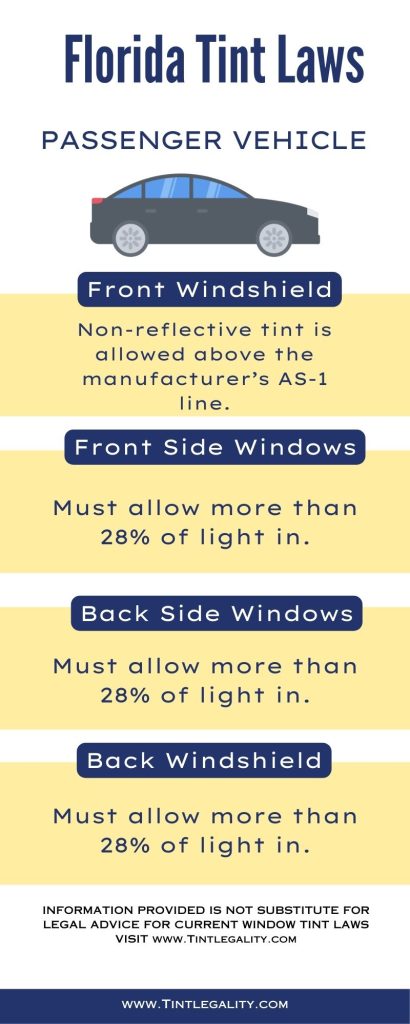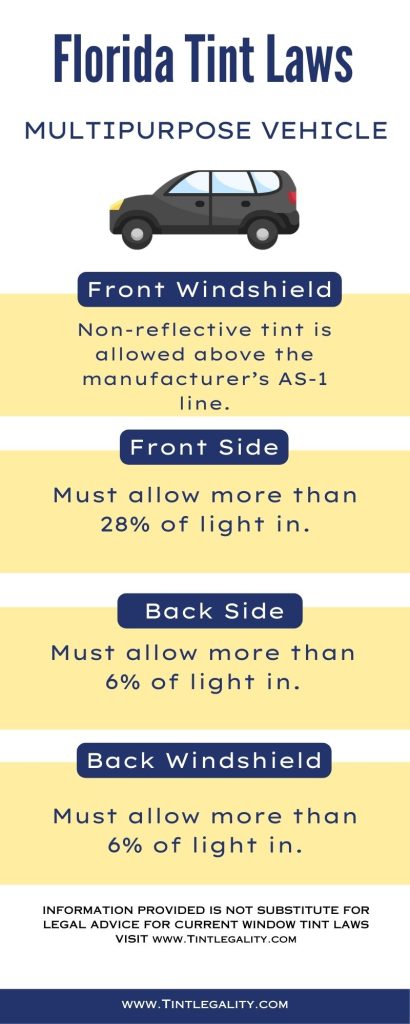Florida tint laws were enacted in 1991 and are designed to ensure that drivers can see out of their car windows while still allowing for some level of tint.
The laws are intended to protect drivers’ and passengers’ safety and the safety of law enforcement officers.
Regulations Regarding Window Tint in Florida
The following are the regulations for window tint in Florida:
| Window Type | Legal Tint Limits |
|---|---|
| Windshield | Top 4 inches: non-reflective, below AS-1 line or 25% surface area |
| Front Side Windows | 28% minimum visible light transmission |
| Back Side Windows | Any level of tint allowed |
| Rear Window | Any level of tint allowed, with side mirrors if tinted |
Windshield
Florida law permits a non-reflective tint on the top four inches of the windshield. However, the tint cannot extend below the AS-1 line or more than 25% of the windshield’s total surface area.
Front Side Windows
The front side windows, including the driver’s side and passenger’s side, must allow a minimum of 28% of outside light to pass through. The 28% rule also applies to the small triangular windows in front of the side mirrors.
Back Side Windows
The back side windows, including the rear passenger windows, can have any level of tint.
Rear Window
The rear window can have any level of tint, but if the vehicle has side mirrors, it must allow a minimum of 15% of outside light to pass through.


Additional Regulations
Reflection
Florida law prohibits window tint that is more than 25% reflective.
Medical Exemptions
Individuals with medical conditions that require them to be shielded from the sun’s rays can apply for a medical exemption from Florida’s tint laws.
The exemption allows for a darker tint on the front side windows and windshield than what is typically allowed by law.
Color Restrictions
Florida law prohibits window tint that is red, blue, or any color other than a standard tinted color.
Side Mirrors
If the rear window is tinted, Florida law requires two side mirrors on the vehicle.
Exceptions to Legal Limits
Florida law provides a few exceptions to the legal limits for window tint.
For example, vehicles owned by diplomats or government officials may have a darker tint.
Additionally, limousines and other vehicles that carry passengers for hire may have a darker tint on the back side windows.
Penalties for Breaking the Law
Fines
If you violate Florida’s tint laws, you may receive a citation and be required to pay a fine. The fine for a first offense is $129. A second offense carries a fine of $258, and a third offense carries a fine of $385.
First Conviction
If you are convicted of violating Florida’s tint laws, you will receive a non-moving violation. This means that you will not receive points on your driver’s license.
Second Conviction
If you are convicted of violating Florida’s tint laws a second time within five years of the first offense, you will receive a moving violation. This means that you will receive points on your driver’s license.
Third Conviction
If you are convicted of violating Florida’s tint laws a third time within five years of the first offense, you will receive a moving violation and may have your driver’s license suspended.
Other Penalties
If you are caught driving a vehicle with illegal window tint, law enforcement officers may require you to remove the tint before you can continue driving the vehicle.
Penalties for Non-Compliance
If you fail to comply with a citation or court order related to illegal window tint, you may face additional fines or even jail time.
In conclusion, understanding Florida’s tint laws is essential for anyone who drives in the state.
By complying with the regulations and choosing legal window tint, you can avoid penalties and enjoy the benefits of a safer, more comfortable driving experience.
Is 20% tint legal in Florida?
No, the legal limit for front side windows is 28%.
Is 7% tint legal in Florida?
No, the legal limit for front side windows is 28%.
Is 70% tint legal in Florida?
Yes, any level of tint is legal on the rear window.
Does Florida have a tint exemption?
Yes, individuals with medical conditions can apply for a medical exemption.
References: